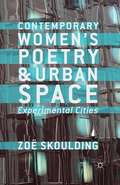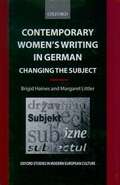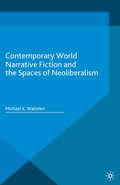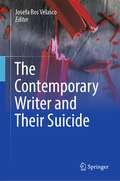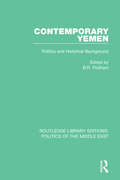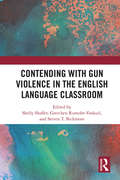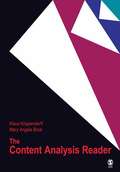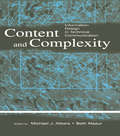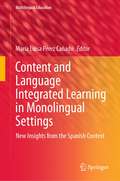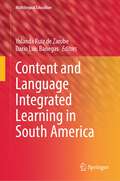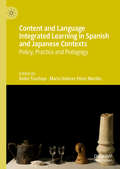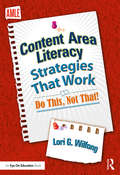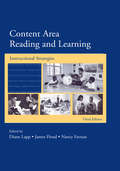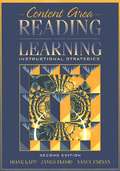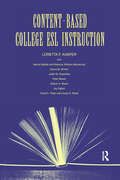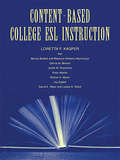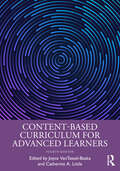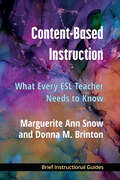- Table View
- List View
Contemporary Women's Poetry and Urban Space: Experimental Cities
by Z. SkouldingThis book focuses on the role of the city, and its processes of mutual transformation, in poetry by experimental women writers. Readings of their work are placed in the context of theories of urban space, while new visions of the contemporary city and its global relationships are drawn from their innovations in language and form.
Contemporary Women's Writing in German: Changing the Subject (Oxford Studies In Modern European Culture)
by Brigid Haines Margaret LittlerSix key texts by contemporary women writers are read afresh by leading critics, using insights from poststructuralist and new materialist feminist theory. Ingeborg Bachmann, Christa Wolf, and Elfriede Jelinek have long been prominent in the fields of Austrian modernism, GDR writing, and avant-garde Austrian literature. The innovative work of Anne Duden, Herta Müller, and Emine Sevgi Özdamar sets out to challenge dominant models of German identity. Focusing on the body and suffering, they explore textual representations of trauma, national identity, and displacement. Haines and Littler's readings of these distinguished and complex female authors offer new avenues for discussion. Both critics and their subjects cast a sceptical eye over existing notions of subjectivity in relation to language, gender, and race. Together, they spark controversy and comment, in an increasingly important debate.
Contemporary World Narrative Fiction and the Spaces of Neoliberalism (New Comparisons in World Literature)
by Michael K. WalonenThis book is a transnational study of how contemporary fiction writers from the United States and Canada to Nigeria to India to Dubai have conceptualized the emergent social spaces of the diverse corners of the neoliberal world system. Over the span of the past three to four decades, free market economic policies have been sold to or pushed upon every society on the globe in some way, shape, or form. The upshot of this has been a world system structured in terms of a vast shift of power and resources from government to private enterprise, dwindling civic life replaced by rising consumerism, an emerging oligarchic rentier class, large segments of population faced with meager material conditions of existence and few prospects of socio-economic mobility, and a looming sense of a near future dominated by further economic collapses and mounting social strife. This book analyses a wide cultural array of some of the most poignant narrative engagements with neoliberalism in its various localized manifestations throughout the world.
The Contemporary Writer and Their Suicide
by Josefa Ros VelascoThis volume is the continuation of the book Suicide in Modern Literature, edited by Josefa Ros Velasco. Considering the positive reception of this book, Ros Velasco launches the second part, entitled The Contemporary Writer and their Suicide. This time, leading representatives of various disciplines analyze the literary, philosophical, and biographical works of contemporary writers worldwide who attempted to commit suicide or achieved their goal, looking for covert and overt clues about their intentions in their writings. This book aims to continue shedding light on the social and structural causes that lead to suicide and on the suicidal mind, but also to show that people assiduous to writing usually reflect their intentions to commit suicide in their writings, to explain how these frequently veiled intentions can be revealed and interpreted, and to highlight the potential of artistic, philosophical, and autobiographical writing as a tool to detect suicidal ideation and prevent its consummation in vulnerable people. This book analyzes several case studies and their allusions to their contexts and the socio-structural and environmental violence and pressures they suffered, expressions of their will and agency, feelings of dislocation between the individual, reality, and existential alienation, and literary styles, writing techniques, and metaphorical language.
Contemporary Yemen: Politics and Historical Background
by B. R. PridhamThis book presents some papers presented to a symposium on contemporary Yemen held in July 1983 by Exeter University's Centre for Arab Gulf Studies in collaboration with the Universities of Aden and San'a', and deals with history, internal and international politics, and administrative subjects.
Contemporary Yemen: Politics and Historical Background
by B. R. PridhamThis book presents some papers presented to a symposium on contemporary Yemen held in July 1983 by Exeter University's Centre for Arab Gulf Studies in collaboration with the Universities of Aden and San'a', and deals with history, internal and international politics, and administrative subjects.
Contending with Gun Violence in the English Language Classroom
by Shelly Shaffer Gretchen Rumohr-Voskuil Steven T. BickmoreUtilizing experiences and expertise from English educators, young adult literature authors, classroom teachers, and mental health professionals, this book considers how secondary English Language Arts can address school gun violence. Curated by field experts, contributions to this volume pay special attention to how a school’s culture and climate affect how teachers and students communicate around difficult topics that are embedded in the curriculum, but not directly addressed. As the first book that helps teachers and teacher educators to grapple with the topic of school violence specifically in the English education classroom, this book promotes young adult literature and writing activities that address timely and unfortunately recurring events.
Contending with Gun Violence in the English Language Classroom
by Shelly Shaffer Gretchen Rumohr-Voskuil Steven T. BickmoreUtilizing experiences and expertise from English educators, young adult literature authors, classroom teachers, and mental health professionals, this book considers how secondary English Language Arts can address school gun violence. Curated by field experts, contributions to this volume pay special attention to how a school’s culture and climate affect how teachers and students communicate around difficult topics that are embedded in the curriculum, but not directly addressed. As the first book that helps teachers and teacher educators to grapple with the topic of school violence specifically in the English education classroom, this book promotes young adult literature and writing activities that address timely and unfortunately recurring events.
The Content Analysis Reader
by Klaus Krippendorff Mary Angela BockPresenting a collection of studies that exemplify what content analysts do and how they solve problems in applying this methodology, this book offers readers additional insights into designing and conducting their own research. It enables readers to learn the process of conducting content analysis research whether used as a companion to Krippendorff′s Content Analysis text, as a supplemental text for content analysis courses, or as an introduction to content analysis by examples.
Content and Complexity: information Design in Technical Communication
by Michael J. Albers Beth MazurInformation design is an emerging area in technical communication, garnering increased attention in recent times as more information is presented through both old and new media. In this volume, editors Michael J. Albers and Beth Mazur bring together scholars and practitioners to explore the issues facing those in this exciting new field. Treating information as it applies to technical communication, with a special emphasis on computer-centric industries, this volume delves into the role of information design in assisting with concepts, such as usability, documenting procedures, and designing for users. Influential members in the technical communication field examine such issues as the application of information design in structuring technical material; innovative ways of integrating information design within development methodologies and social aspects of the workplace; and theoretical approaches that include a practical application of information design, emphasizing the intersection of information design theories and workplace reality. This collection approaches information design from the language-based technical communication side, emphasizing the role of content as it relates to complexity in information design. As such, it treats as paramount the rhetorical and contextual strategies required for the effective design and transmission of information. Content and Complexity: Information Design in Technical Communication explores both theoretical perspectives, as well as the practicalities of information design in areas relevant to technical communicators. This integration of theoretical and applied components make it a practical resource for students, educators, academic researchers, and practitioners in the technical communication and information design fields.
Content and Complexity: information Design in Technical Communication
by Michael J. Albers Mary Beth MazurInformation design is an emerging area in technical communication, garnering increased attention in recent times as more information is presented through both old and new media. In this volume, editors Michael J. Albers and Beth Mazur bring together scholars and practitioners to explore the issues facing those in this exciting new field. Treating information as it applies to technical communication, with a special emphasis on computer-centric industries, this volume delves into the role of information design in assisting with concepts, such as usability, documenting procedures, and designing for users. Influential members in the technical communication field examine such issues as the application of information design in structuring technical material; innovative ways of integrating information design within development methodologies and social aspects of the workplace; and theoretical approaches that include a practical application of information design, emphasizing the intersection of information design theories and workplace reality. This collection approaches information design from the language-based technical communication side, emphasizing the role of content as it relates to complexity in information design. As such, it treats as paramount the rhetorical and contextual strategies required for the effective design and transmission of information. Content and Complexity: Information Design in Technical Communication explores both theoretical perspectives, as well as the practicalities of information design in areas relevant to technical communicators. This integration of theoretical and applied components make it a practical resource for students, educators, academic researchers, and practitioners in the technical communication and information design fields.
Content and Language Integrated Learning in Monolingual Settings: New Insights from the Spanish Context (Multilingual Education #38)
by María Luisa Pérez CañadoThis book offers new empirical insights into the current state of Content and Language Integrated Learning (CLIL) characterisation (through an innovative proposal to link CLIL to English as a Lingua Franca), implementation (via observation protocols and SWOT analyses), and research (by examining the effects of CLIL on the L1, foreign language, key competences, and content subjects taught through English). The book provides a state of the art of the CLIL arena, identifies the chief challenges that need to be addressed and signposts possible ways of overcoming these in order to continue advancing smoothly into the next decade of CLIL development. This book will be of interest to researchers, policy-makers, educational authorities, and practitioners as it will assist them in making informed decisions about how to characterise, implement, and investigate CLIL in the bi- and plurilingual programs that are more frequently introduced in monolingual contexts.
Content and Language Integrated Learning in South America (Multilingual Education #46)
by Yolanda Ruiz de Zarobe Darío Luis BanegasCLIL is a pedagogical approach which has gained traction in different educational and geographical contexts as a key tool in language learning and teaching. After more than 25 years of implementation, we can assert that we have learned a great deal about what CLIL entails. However, it is also true that we still need to contextualise the approach in order to clearly delimit what CLIL has to offer in each setting. This is precisely the aim of this book. This volume focuses on CLIL in South American contexts. It identifies, clarifies and offers insights into issues related to its characterisation and implementation, as well as teacher education. With contributions from a prestigious array of scholars and practitioners from various parts of South America, it also highlights some of the achievements and challenges in the process of implementing CLIL in the region. Against the backdrop of South American contexts, this book aims to provide a useful and innovative lens through which policy makers, researchers and teachers will find significant implications for the development of CLIL.
Content and Language Integrated Learning in Spanish and Japanese Contexts: Policy, Practice and Pedagogy
by Keiko Tsuchiya María Dolores Pérez MurilloThis edited book compiles pedagogical practices and studies of Content and Language Integrated Learning (CLIL) from two sites: Spain, where CLIL has been widely implemented for more than a decade, and Japan, where the CLIL approach is still in its relative infancy, and quickly gaining momentum. Focusing on three aspects of the CLIL implementations: policy, practice and pedagogy, the authors describe how CLIL has evolved in distinctive socio-political, historical and cultural contexts. The chapters range across primary, secondary and tertiary education, and examine English language teaching and learning at both the macro level - through language education policy - and the micro level - with a focus on classroom interaction and pedagogy. This book fills a gap in the English as a Medium of Instruction (EMI) literature, and will be of particular interest to language teachers, teacher trainers, and students and scholars of applied linguistics more broadly.
Content Area Literacy Strategies That Work: Do This, Not That!
by Lori G. WilfongContent area teachers are now being tasked with incorporating reading and writing instruction, but what works? In this essential book from Routledge and AMLE, author Lori G. Wilfong describes ten best practices for content area literacy and how to implement them in the middle-level classroom. She also points out practices that should be avoided, helping you figure out which ideas to ditch and which to embrace. Topics covered include… Building background knowledge quickly Using specific strategies to scaffold focus while reading Using small group reading strategies to bring personal response and accountability to the content Understanding items that make reading in different disciplines unique Teaching content area vocabulary in meaningful ways Making writing an authentic process through daily and weekly assignments Planning and teaching effective informational and argumentative pieces Each chapter includes Common Core connections and practical templates and tools. The templates are available as free eResources so you can easily print them for classroom use.
Content Area Literacy Strategies That Work: Do This, Not That!
by Lori G. WilfongContent area teachers are now being tasked with incorporating reading and writing instruction, but what works? In this essential book from Routledge and AMLE, author Lori G. Wilfong describes ten best practices for content area literacy and how to implement them in the middle-level classroom. She also points out practices that should be avoided, helping you figure out which ideas to ditch and which to embrace. Topics covered include… Building background knowledge quickly Using specific strategies to scaffold focus while reading Using small group reading strategies to bring personal response and accountability to the content Understanding items that make reading in different disciplines unique Teaching content area vocabulary in meaningful ways Making writing an authentic process through daily and weekly assignments Planning and teaching effective informational and argumentative pieces Each chapter includes Common Core connections and practical templates and tools. The templates are available as free eResources so you can easily print them for classroom use.
Content Area Reading and Learning: Instructional Strategies, 3rd Edition
by James Flood Diane Lapp Nancy FarnanHow can teachers make content-area learning more accessible to their students? This text addresses instructional issues and provides a wealth of classroom strategies to help all middle and secondary teachers effectively enable their students to develop both content concepts and strategies for continued learning. The goal is to help teachers model, through excellent instruction, the importance of lifelong content-area learning. This working textbook provides students maximum interaction with the information, strategies, and examples presented in each chapter. This book is organized around five themes: Content Area Reading: An Overview The Teacher and the Text The Students The Instructional Program School Culture and Environment in Middle and High School Classrooms. Pedagogical features in each chapter include: a graphic organizer; a chapter overview, Think Before, Think While and Think After Reading Activities - which are designed to integrate students’ previous knowledge and experience with their new learnings about issues related to content area reading, literacy, and learning, and to serve as catalysts for thinking and discussions.This textbook is intended as a primary text for courses on middle and high school content area literacy and learning.
Content Area Reading and Learning: Instructional Strategies, 3rd Edition
by James Flood Diane Lapp Nancy FarnanHow can teachers make content-area learning more accessible to their students? This text addresses instructional issues and provides a wealth of classroom strategies to help all middle and secondary teachers effectively enable their students to develop both content concepts and strategies for continued learning. The goal is to help teachers model, through excellent instruction, the importance of lifelong content-area learning. This working textbook provides students maximum interaction with the information, strategies, and examples presented in each chapter. This book is organized around five themes: Content Area Reading: An Overview The Teacher and the Text The Students The Instructional Program School Culture and Environment in Middle and High School Classrooms. Pedagogical features in each chapter include: a graphic organizer; a chapter overview, Think Before, Think While and Think After Reading Activities - which are designed to integrate students’ previous knowledge and experience with their new learnings about issues related to content area reading, literacy, and learning, and to serve as catalysts for thinking and discussions.This textbook is intended as a primary text for courses on middle and high school content area literacy and learning.
Content Area Reading and Learning: Instructional Strategies
by Diane Lapp James Flood Nancy FarnanHow can teachers make content-area learning more accessible to their students? This text addresses instructional issues and provides a wealth of classroom strategies to help all middle and secondary teachers effectively enable their students to develop both content concepts and strategies for continued learning. The goal is to help teachers model, through excellent instruction, the importance of lifelong content-area learning. This working textbook provides students maximum interaction with the information, strategies, and examples presented in each chapter. Content Area Reading and Learning: Instructional Strategies, Third Edition is organized around five themes: Content Area Reading: An Overview The Teacher and the Text The Students The Instructional Program School Culture and Environment in Middle and High School Classrooms Pedagogical features: Each chapter includes a graphic organizer, a chapter overview, a Think Before Reading Activity, one or more Think While Reading Activities, and a Think After Reading Activity. The activities present questions and scenarios designed to integrate students’ previous knowledge and experience with their new learnings about issues related to content area reading, literacy, and learning, and to serve as catalysts for thinking and discussions. New in the Third Edition The latest information on literacy strategies in every content area Research-based strategies for teaching students to read informational texts Up-to-date information for differentiating instruction for English-speaking and non-English speaking students An examination of youth culture and the role it plays in student learning A look at authentic learning in contexts related to the world of work Ways of using technology and media literacy to support content learning Suggestions for using writing in every content area to enhance student learning Ideas for using multiple texts for learning content A focus on the assessment-instruction connection Strategies for engaging and motivating students Content Area Reading and Learning: Instructional Strategies, Third Edition, is intended as a primary text for courses on middle and high school content area literacy and learning.
Content Area Reading and Learning: Instructional Strategies
by Diane Lapp James Flood Nancy FarnanHow can teachers make content-area learning more accessible to their students? This text addresses instructional issues and provides a wealth of classroom strategies to help all middle and secondary teachers effectively enable their students to develop both content concepts and strategies for continued learning. The goal is to help teachers model, through excellent instruction, the importance of lifelong content-area learning. This working textbook provides students maximum interaction with the information, strategies, and examples presented in each chapter. Content Area Reading and Learning: Instructional Strategies, Third Edition is organized around five themes: Content Area Reading: An Overview The Teacher and the Text The Students The Instructional Program School Culture and Environment in Middle and High School Classrooms Pedagogical features: Each chapter includes a graphic organizer, a chapter overview, a Think Before Reading Activity, one or more Think While Reading Activities, and a Think After Reading Activity. The activities present questions and scenarios designed to integrate students’ previous knowledge and experience with their new learnings about issues related to content area reading, literacy, and learning, and to serve as catalysts for thinking and discussions. New in the Third Edition The latest information on literacy strategies in every content area Research-based strategies for teaching students to read informational texts Up-to-date information for differentiating instruction for English-speaking and non-English speaking students An examination of youth culture and the role it plays in student learning A look at authentic learning in contexts related to the world of work Ways of using technology and media literacy to support content learning Suggestions for using writing in every content area to enhance student learning Ideas for using multiple texts for learning content A focus on the assessment-instruction connection Strategies for engaging and motivating students Content Area Reading and Learning: Instructional Strategies, Third Edition, is intended as a primary text for courses on middle and high school content area literacy and learning.
Content-Based College ESL Instruction
by Loretta F. Kasper Marcia Babbitt Rebecca William Mlynarczyk Donna M. Brinton Judith W. RosenthalThis book is carefully designed to inform and train readers in the techniques of content-based ESL instruction and to assist them in developing and implementing content-based materials and programs appropriate to their educational institutions and situations. Every chapter presents a balance of theory and practice, focusing on a detailed description, with clear examples of classroom practices including information, suggestions, and instructional tools. Each chapter addresses assessment issues as they apply to the particular methodology described.
Content-Based College ESL Instruction
by Loretta F. Kasper Marcia Babbitt Rebecca William Mlynarczyk Donna M. Brinton Judith W. RosenthalThis book is carefully designed to inform and train readers in the techniques of content-based ESL instruction and to assist them in developing and implementing content-based materials and programs appropriate to their educational institutions and situations. Every chapter presents a balance of theory and practice, focusing on a detailed description, with clear examples of classroom practices including information, suggestions, and instructional tools. Each chapter addresses assessment issues as they apply to the particular methodology described.
Content-Based Curriculum for Advanced Learners
by Joyce VanTassel-Baska and Catherine A. LittleThe fourth edition of Content-Based Curriculum for High-Ability Learners provides readers with a complete and up-to-date introduction to core elements of curriculum development in gifted education with implications for school-based implementation. Written by key experts in the field, this text is essential to the development of high-powered, rich, and complex curricula that treat content, process, product, and concept development considerations as equal partners in the task of educating gifted learners. Along with revised chapters, this edition contains new chapters on culturally responsive curriculum, the performing arts, robotics, and engineering design, as well as social and emotional learning. Additional material concerning talent trajectories across the lifespan accompanies a discussion of honors curriculum in higher education, rounding out this comprehensive resource. This master text is a must read for educators interested in executing effective curriculum and instructional interventions to support learning for gifted and advanced learners.
Content-Based Curriculum for Advanced Learners
by Joyce VanTassel-Baska Catherine A. LittleThe fourth edition of Content-Based Curriculum for High-Ability Learners provides readers with a complete and up-to-date introduction to core elements of curriculum development in gifted education with implications for school-based implementation. Written by key experts in the field, this text is essential to the development of high-powered, rich, and complex curricula that treat content, process, product, and concept development considerations as equal partners in the task of educating gifted learners. Along with revised chapters, this edition contains new chapters on culturally responsive curriculum, the performing arts, robotics, and engineering design, as well as social and emotional learning. Additional material concerning talent trajectories across the lifespan accompanies a discussion of honors curriculum in higher education, rounding out this comprehensive resource. This master text is a must read for educators interested in executing effective curriculum and instructional interventions to support learning for gifted and advanced learners.
Content-Based Instruction: What Every ESL Teacher Needs to Know
by Ann Snow Donna BrintonThis book introduces readers to the concept of Content-Based Instruction (CBI) through a brief history and countless examples of the many ways this approach can be applied across settings and programs. Whether readers want to deepen their understanding of CBI or get ideas for their own teaching situation, this book provides an overview of CBI and the process of implementing it. The book discusses the three prototype models (theme-based, sheltered, and adjunct), new models (sustained content language teaching, content and language-integrated learning, English-medium instruction, adjunct models, and other hybrid models), and a research-based rationale for using CBI in the classroom. Each section includes reflection questions designed to guide readers to consider how best to implement CBI in their course and program.
